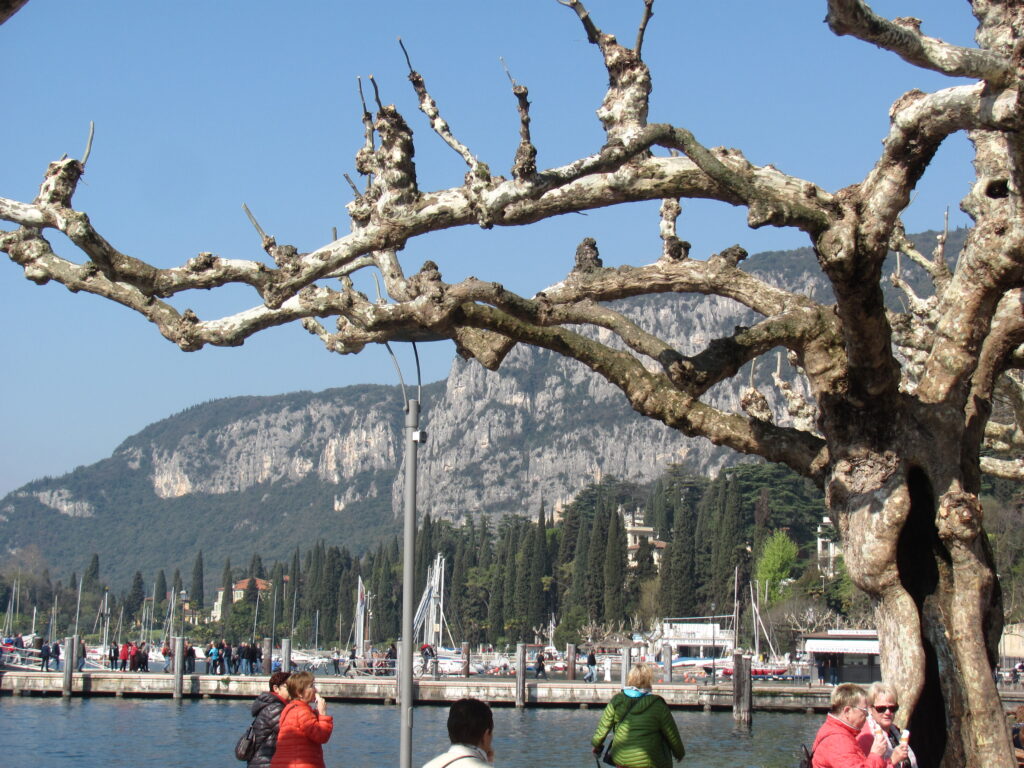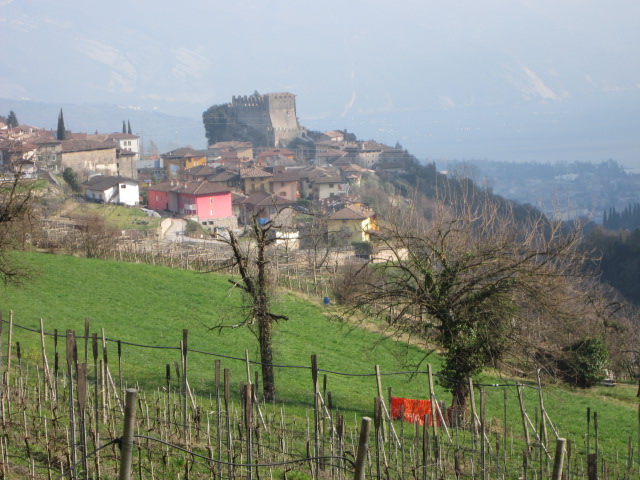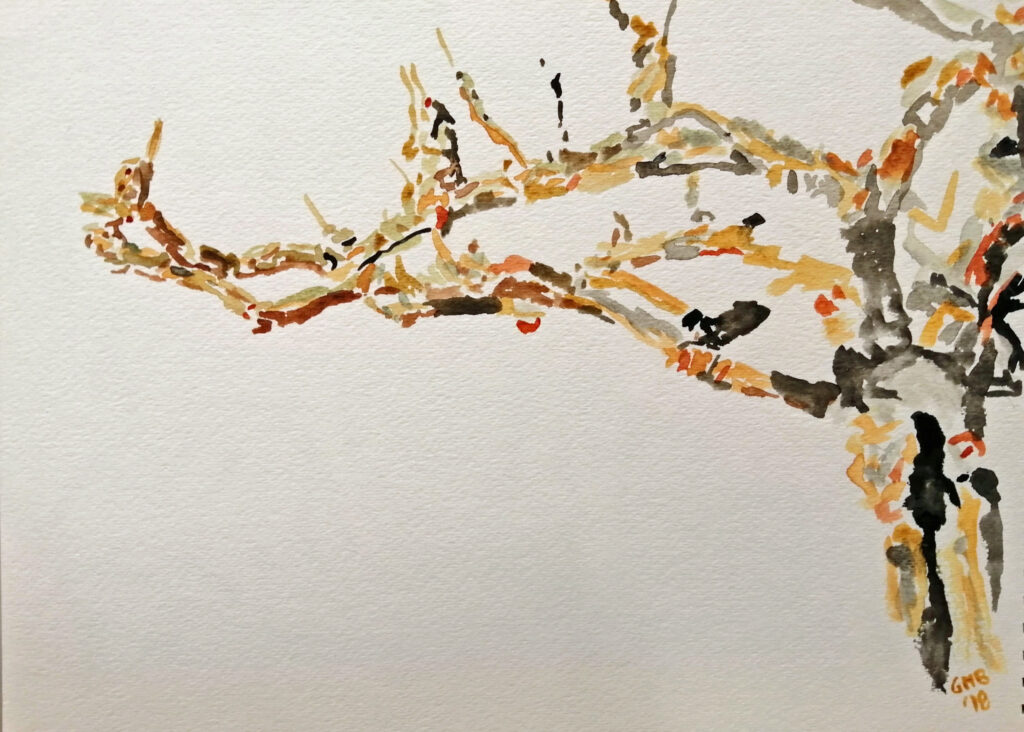This is a guest post by Nivea Bona. It is the first in a series of posts by people who are champions of my art. In this post, Bona makes a link between how we care for and see trees and art in our lives. It is based on a trip to Italy where the above painting, A Tree in Tenno, was first imagined.
A painted tree is not only a tree. Nor is it art. It is a whole moment.
A tree.
Have you ever thought of how many trees you see every day? Do you pay attention to them?
In a society that focuses on productivity and results, money and status, trees are the least of anyone’s worries.
But trees can also be a fancy and luxurious commodity. Just look at Bonsai! Trees can occupy high positions in our society, with people devoting their lives to caring for them. Sometimes, the skills required for caring for trees are traditional and handed down from one generation to the next, and, depending on the species and treatment, they can be very valuable and shine in tree competitions around the world.
We could say that our society perceives art and trees in a very similar way.
Are Trees and Art Similar?
In this very positivistic line of thought, where the value of everything is directly linked to its functionality, a lot has been discussed about the “role” of art in our society. As it does with trees, a big portion of humanity keeps ignoring art. And another portion, as it does with trees, deems art unattainable for most of the population. That is why there are people buying cheap prints from Target to have something on their office walls and, on the other hand, there are people hiring curators to search, study, find, and buy specific works of art that are already, or will soon become, very valuable.
In the middle of these two extremes described above, there are those who like art, who spend some time foraging for handcrafted beauty in the world, who don’t have the money to hire professionals to seek a specific painting or sculpture that deserves to be in a collection. These people “in the middle” are the most interesting in my view. They want to know the story behind each work of art. They spend hours in short art courses or online workshops understanding how some artists can transform the simple into the beautiful. Or the anger in colors, or the news in visual protest, or the pain in poetry, or the moment in a shape. These people are those who make the effort to keep art alive in our society. I think you will agree with me that, almost always, they are those who value all the nature around them.
And it is thinking of those people that I decided to tell the story of A Tree in Tenno. Because I was there when this tree was envisioned and when this tree became immortalized in an artist’s creation.

A Crazy Idea
We were living in Brazil and decided to move to the U.S. to help Greg’s family with the business, a bed and breakfast. His grandmother had passed away and left the business in need of family members to care for it. We decided that we could do that and help. But before that, in this interval between a responsible life in Brazil, with safe jobs and routine, and another challenge that was awaiting us, we needed to fulfill a crazy dream, do something very different. That was how we decided to go to Italy and be part of the Worldwide Opportunities in Organic Farms for two weeks.
The program is very interesting. Simply put, you volunteer to work on a farm and the farmer feeds you and gives you a place to stay. You are not paid but you also don’t pay for food or accommodation. You have to work for around 4 hours a day and the rest of your day you are free to get to know the area or invest in another activity. We ended up working with grape vines and olive trees on a property in a small village called Tenno, embedded in the Dolomite mountains, very close to Lago Di Garda. In fact, while working amongst the vines, the view was of the lake.
Those two weeks in March of 2016 were beyond amazing. We braved the cold weather to work, every morning, on organizing the vines and tying them to the lines where they would grow and produce grapes. We also cleaned the field of dry branches, a winter legacy of the grove.
Leisure Leads to Art
After a very Italian (which is synonymous with delicious) lunch, every day, we explored the region. We visited the medieval village of Canale, the shining blue Lago di Tenno, some tunnels in the mountains, and other small neighborhoods. We visited churches, meadows, hills, and valleys. But there was this day that was very special. Not far from our home in Tenno, we decided to sit and observe the valley. On the other side was Pranzo, the village where we had lunch every day. We could wave from one village to another, but there was this smallish valley (with some properties down there too) between the two villages.
We sat on a small stone wall. The air was still crisp, but the sun was making everything around us warm, alive, and vibrant. The feeling of the sun on the skin was like a touch of energy. I breathed. Deeply. There was an immense amount of information to take in. The sun, the blue sky, the echoing sounds of the valley, the chirping of birds, the whooshing of the wind between the trees. The trees. I started to write, trying to explain in words what that synesthetic experience was. Sound, color, smells, warmth, sensations. Impossible to put everything in two or three sentences. Greg was absorbed. His gaze was aimed toward a group of trees. It was as if he was dissecting each of those branches with his eyes.

How Trees Become Art
We spent two hours there in silence. Sucking in that nature, being part of all that symphony that the world was producing in that specific instant. It worked. I carry the feeling of being part of something much bigger and ingenious every time I remember that moment. And one of the triggers for that memory is exactly one specific painting: A Tree in Tenno.
That specific tree is now immortalized in an interpretation; it became art. I don’t know if someone, someday, will buy this painting. I don’t know if people admiring it in the gallery in Lewiston, ME (on the other side of the ocean from the original location and the original tree) have the slightest suspicion about the story of those yellowish branches. But I know that the person taking that painting home is part of that group of people who, when they see a tree or a work of art, also see the magic of a whole moment in it.

